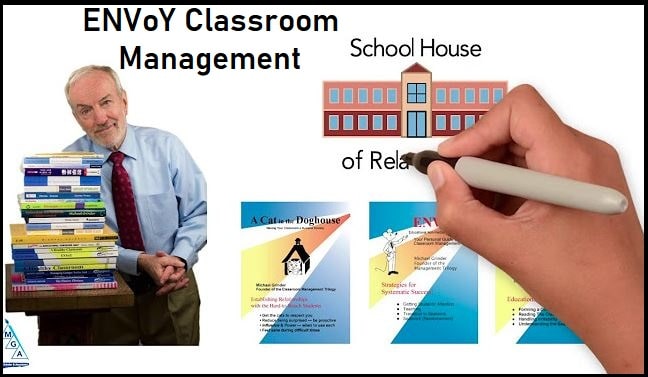Focus on teaching curriculum more and managing behavior less. Discover 7 simple and effective non-verbal strategies for classroom management.
32.95 USD Michael’s timeless educational creation is ENVoY, suitable for all educators as it encompasses the scientific approach to managing a classroom.
What is the ENVoY program?
ENVoY helps educators transition from perceiving themselves as holders of authority to becoming agents of change. When implemented by groups of teachers in a school setting, this resource highlights the individual professional skills of all participants. It is essential to empower ourselves internally.
Systems are required to tap into the diverse abilities found in isolated classrooms. The collective wisdom of the staff only surfaces through sharing and supporting processes.
Your Guide to ENVoY Classroom Management
ENVoY (Educational Nonverbal Yardsticks) is a classroom management program designed to help teachers maintain control of their classrooms using nonverbal techniques. Developed by Michael Grinder, ENVoY emphasizes the power of body language, eye contact, and other subtle cues to guide student behavior without resorting to verbal commands or raising one’s voice.
The core idea behind ENVoY is that nonverbal communication can be far more effective than verbal commands in managing a classroom. Teachers can create a calm, organized, and positive learning environment by mastering these techniques. ENVoY’s strategies include managing transitions smoothly, using visual signals to direct student attention, and positioning oneself in the classroom to maximize influence.
For example, instead of verbally reminding students to focus, a teacher might use a specific hand signal or move to a predetermined spot in the room that signals it’s time to pay attention. These methods are designed to be subtle yet powerful, reducing the need for disruptive interventions and helping maintain the instruction flow.
Implementing ENVoY strategies can lead to a more peaceful classroom atmosphere, where students are more likely to stay engaged and on-task. This approach not only enhances student learning but also reduces stress for both teachers and students, creating a more enjoyable and productive educational experience.
What is the ENVOY book?
Michael’s top-selling book for educators focuses on classroom management strategies and is popular across various continents. The book outlines 31 techniques for teachers to utilize, allowing them to apply the methods when most necessary. Chapter 1 summarizes the seven most effective techniques among the 31 presented. The skills are provided in customizable forms for teachers to complete, which are also available as peer observation competency sheets.
Peer coaching enables rapid professional growth and is considered the quickest method. Additionally, the book covers 24 crucial skills, elaborating on the Seven Gems. These techniques, primarily non-verbal, are often overlooked in teacher training programs despite their significance.
7 simple and effective non-verbal strategies for classroom management
- Silent Signals: Use hand gestures or visual cues to communicate with students, like raising a hand to signal silence or pointing to a task for redirection.
- Strategic Positioning: Move around the classroom to influence student behavior, standing near disruptive students to subtly redirect their attention.
- The Pause: Pause briefly during instruction when students become distracted. The silence often draws their focus back without a word.
- Facial Expressions: Use expressions like a raised eyebrow or a smile to convey approval or disapproval, guiding behavior without interrupting the flow of the lesson.
- Proximity Control: Stand close to off-task students, using your presence to encourage them to refocus without direct confrontation.
- Eye Contact: Make intentional eye contact with students to grab attention or convey a message, reinforcing expectations silently.
- Visual Reminders: Display visual cues or symbols in the classroom that represent rules or procedures, reminding students of expectations without verbal communication or repetition.
The feedback on the ENVoY Program from individuals
Dr. Robert Garmston, Co-director of the Institute for Intelligent Behavior, praised Michael Grinder’s book for its abundant and effective non-verbal classroom management techniques, describing it as a valuable resource that could enhance his observational skills and sense of timing.
Robert Dilts, NLP University
Michael provides the teacher with a valuable set of strategies. Envoy brings a refreshing approach.
Marilyn Ewing, a teacher and Conflict Management coordinator in Ithaca, NY, believes that ENVoY offers a plethora of win-win strategies that are successful in racially and culturally diverse schools.
Kaze Gadway, Program Director, Gadway Training Institute
“Having taught in various cross-cultural settings, such as East Africa, for 25 years, I am impressed by the respectful, straightforward, and efficient approach of Michael Grinder.
FAQ’s on Classroom Management in ENYOY
What is ENVoY in classroom management?
ENVoY, which stands for Educational Nonverbal Yardsticks. It is a set of nonverbal techniques developed by Michael Grinder to help teachers manage their classrooms effectively. It focuses on using body language, and other nonverbal cues to guide student behavior and maintain a positive learning environment.
How does ENVoY differ from traditional classroom management methods?
Unlike traditional methods that rely heavily on verbal commands and discipline, ENVoY emphasizes nonverbal communication. By using subtle gestures, positioning, and visual cues, teachers can manage their classrooms with less disruption and more efficiency.
Can ENVoY techniques be used with all age groups?
Yes, ENVoY techniques are adaptable and can be used with students of all ages. The principles of nonverbal communication are universal, making them effective in various educational settings, from elementary to high school.
What are some examples of ENVOY strategies?
Examples include using a specific hand signal to regain students’ attention. By positioning yourself strategically in the classroom to influence behavior, and employing visual aids to communicate expectations. These strategies are designed to minimize disruptions and maintain the flow of instruction.
Do ENVoY techniques require special training?
While the concepts behind ENVoY can be understood quickly. Specialized training or workshops are often recommended to fully master the techniques. Training helps teachers learn how to apply these strategies effectively in their unique classroom environments.
What are the benefits of using ENVoY in the classroom?
ENVoY techniques can lead to a more organized and calm classroom atmosphere. it reduce the need for verbal corrections, and increase student engagement. They also help in creating a more positive and less stressful environment for both students and teachers.

